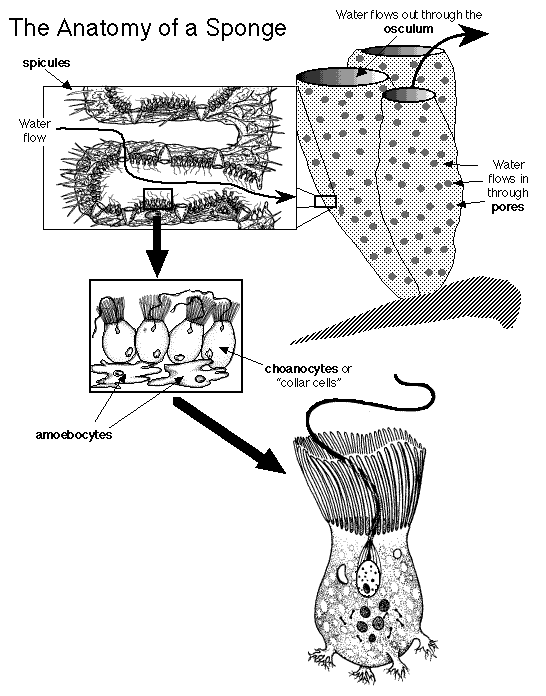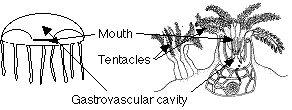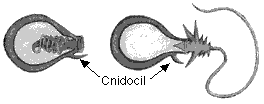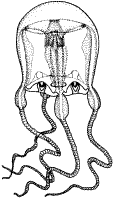
| Dept of Biology, Lewis and Clark College | Dr Kenneth Clifton
|
|
Biology
221 Lecture Outline
|
Lecture 9: Introduction to marine animals and the biology of "lower" invertebrates: sponges, cniderians, and worms
Unlike photosynthetic organisms that make their own food using solar energy, marine animals must consume other organisms to acquire energy.
Because of respiration: animals need oxygen, nitrogen, carbon. The first two can often be limiting in marine habitatsWaste products often disperse rapidly in marine environments.... but buildups can occur
There are many different names for different kinds of consumers:
By dietHerbivores (plant material)Detritivores (microbial material.... plant and animal organic compounds)
Carnivores (animal material).
By style: the gray line between predation and parasitism
Predator: often kills prey to acquire energyParasite: often does not kill host to acquire energy
Parasites often have several hosts
Also by location.... free swimming, attached, interstitial.... we will talk about this later
Like plants, some marine animals can reproduce sexually and asexually. Some are obligate sexual reproducers.
Many marine animals also have a bipartite life history
Population dynamics may be very different that terrestrial systems
The food/sex/death mantra as a way of understanding adaptations
Now... let's think about marine animals:
Life evolved in the oceans.... thus the study of marine life is a study of evolution.
We will examine taxonomic diversity of animals within the marine environment by moving up the evolutionary tree...
that is, from some of the earliest life forms to some of the most recent
Sponges are one of the most primitive animals... one of the first steps in multicellular life.
The range in size from a few cm up to 2 m. Sponge symmetry is either radial or nonexistent
They lack true tissues, and consist primarily of three types of cells:
a) flagellated feeding cells (choanocytes or "collar" cells) that draw water from outside through a series of pores.b) epithelial cells (pinacocytes or porocytes) that form the outer "skin" of the sponge
c) amoeboid cells (amoebocytes) that move freely between the choanocytes and the epithelial cells in a gelatinous protein matrix called mesenchyme. These cell aid in the digestion and distribution of nutrients
The central cavity is called the spongocoel
Skeletal structure of collagen and calcareous or siliceous spicules provides structural support and defense against predators
Sponges have few enemies. Many are chemically distasteful. A few species of fish (e.g., angelfishes, parrotfishes), seaslugs and hawksbill turtles eat spongesSponges provide habitat for wide variety of animals. Over 12,000 animals (mostly shrimp) have been found in a single loggerhead sponge.
Sponges come in many shapes and forms. Taxonomy of the group is under constant revision. Virtually all of the 5,000 - 9,000 species of sponges are marine, however (100 or so live in fresh water)
They are relatively simple!
Sponges have no organs or true tissues; their digestion is intracellular and both excretion and respiration are by diffusion.
Nervous system effectively absent, although there is some "communication" between cells
All adults sessile and attached to substratum... but those in aquaria can move verrrrrrrry slowly!
Asexual reproduction by budding or fragmentation or....
Sexual reproduction by eggs and sperm. Zygotes develop into free-swimming, ciliated larvae.

The jellies, anemones, hydroids, soft corals, and stony corals are all in the phylum Cnideria
Like sponges, these simple animals follow a radial body plan
Cniderians are built upon a common polyp body plan: cup shaped with a ring of tentacles surrounding a single opening digestive tract: when these are inverted and free swimming, it is called a medusa. The gelatenous protein matrix that gives jellies thier distinctive feel is called mesoglea

Cniderians are named after the Greek word for "stinging nettle" because they contain stinging cells called nematocysts
A nematocyst contains a spirally folded, venom-filled thread. When the sensor (cnidocil) is stimulated either physically or chemically, the capsule everts, ejecting the thread with sufficient force to inject venom and/or entangle the target

Muscles and nerves are present, but in their simplest form
Scyphozoans: the true jellies
Hydrozoans: Hydroids, including the colonial hydroids like the Portuguese Man of War
Hydroid life cycles often alternate between a more conspicuous polyp stage and a medusa stage
Cubozoans: Sea Wasps.... these often posses very toxic nematocysts

Anthozoans
Actineria (Sea anemones)
Octocorallia (gorgonians and seafans)
Zoantharia (colonial anemones that share tissue)
Scleractinia (stony corals)
What are zooxanthellae? Many anthozoans have a symbiotic relationship with zooxanthellae, microscopic algae that live within the tissues of the polyp. The zooxanthellae produce oxygen and carbohydrates that the polyp can use for nutrition. In turn, the polyp provides carbon dioxide to the zooxanthellae. The extra energy available to the polyp allows it shunt more to growth... This is particularly important for reef-building corals, because the removal of carbon dioxide by the zooxanthellae allow the polyp to build a calcareous skeleton faster than it can be eroded by physical and biological processes. Thus, coral reefs ultimately owe their persistence to these microscopic algae. "Jellyfish Lake", in Palau, reveals what happens when the defensive and feeding needs provided by nematocysts become unnecessary.
Flatworms (phylum Platyhelminthes) and other acoelomates represent another very primitive group. These animals lack a body cavity, but show bilateral, rather than radial symmetry. As such, they represent a very important evolutionary step... allowing for cephalization....the concentration of sensory abilities in the anterior part of an animal
Flatworms known as flukes represent an important group of parasites with complex life cycles and several intermediate hosts such as birds, molluscs, and fish.... these are mostly a nuisance rather than a danger to humans, however, some can be very nasty.
Ribbon worms (phylum Nemertea) are mobile carnivores that burrow in sand and mud. They have a complete gut and anus. They are also acoelomates.
Roundworms (phylum Nematoda) are found in many marine environments... primarily because their ability to use longitudinal muscles against a fluid filled body cavity allows much greater levels of mobility.... They can occur in densities of 106/m2. They are pseudocoelomates.
Segmented Worms (phylum Annelida) are very advanced worms with segmented bodies, complex mouth parts and relatively well developed nervous system. They, like other more derived groups, are coelomates.
Polychaete worms have two parapodia on each segment. These have stiff bristles called setae, which aid in locomotion and defense (e.g. fire worms). They can feed on plant, animal, or detrital material.Oligochaete worms lack parapodia (like earthworms) and typically eat sedimentary organic material
Leeches use external suckers both to move and to parasitize larger hosts by drawing off bodily fluids
Peanut Worms (phylum Sipuncula) live in burrows or crevices and lack body segments. They use fluid pressure to extend an introvert with feeding tentacles.
Gutless Worms (phylum Pogonophora) are typically found in deep sea environments. They lack a true gut and depend upon symbiotic bacteria for their nutrition (either by ingesting the bacteria directly or by consuming the byproducts of bacteria.
Within the worms we see progression in the evolution of a body cavity (coelom)...